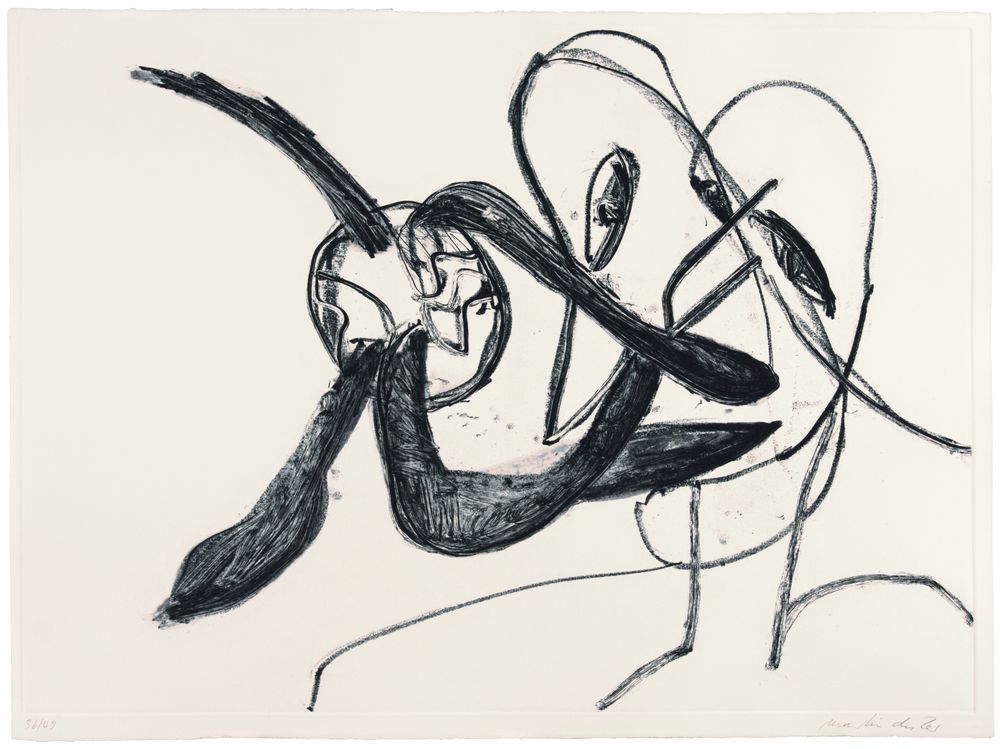Box with eight etchings on Van Gelder-paper, one additonal cover sheet, one pocket knife and a tape recording with the inscription "Nigger-Joint Cabaret"
Aquatint, soft ground etching, lift ground, drypoint and photoetching
Dimensions: 56 x 75.4 cm each
Signature, inscriptions, markings: each signed at lower right, numbered at lower left
Copy Number: 36/49
Printer: Paul Mancusi, Aero Press Inc., New York
Publisher: Peter Blum, New York
Text: Martin Disler
Accession Number: 1001039.1–8
Image: Sheet 5
The signal color red immediately catches the attention - in black capital letters artist name and title fill the entire format of the cassette. Opening it, one first finds a kind of cover plate with a black jackknife and the audio cassette Nigger-Joint Cabaret labeled in red. Below that is the actual cover plate with the red initials M. D. In this early portfolio, Martin Disler takes advantage of the various techniques of etching to express his style - full of energy and drive. The color black plays a special role for him; in an interview he expressed, "In etching I have found the blackest black. To the blackest black belongs my undivided sympathy!"2 The importance of black is also crystallized in the accompanying audio recording Nigger-Joint Cabaret, in which Disler recites his enigmatically expressive texts that complement the graphics. These are text passages, some spoken, some sung, subdivided by the refrain: Endless Modern Licking of Crashing Globe by Black Doggie Time-Bomb as well as Und der Mond hackt das Loch in den Schiffsbauch (And the moon chops the hole in the belly of the ship). Disler's lyrics contain German phrases mixed with English; they refer to New York. He refers to himself as Black Doggie, the color black recurs, literally and in the form of things that are originally black. For the artist, writing poetry and articulating his own voice signify the expression of an "idea of freedom" that has also carried over into his painting. "Writing, drawing, painting, that is the way into the depths, where the images reside."3 The formulations should be as sharp as a knife, both in content and figuratively. It is not for nothing that a pocket knife is enclosed with the series.
The illustrated sheet shows two heads consisting of frighteningly jagged lines - of indeterminate gender - that seem to grow out of a neck. Snake-like formations coil out of them like tongues and pierce a globe. Clearly visible are the lines of line etching left by the blunt pencil on the grainy textured picture surface. Possibly a text passage of the sound recording gives clues for an interpretation: "Dearest! Have long mistaken you for the globe! I crawled into a gun barrel, kept a lookout in your basket. How could I forget that you are a ship? We go up and down in it." Disler worked in New York with his partner, Irene Grundel - Grundel means "ship" in Dutch.
This series was created when he set up a studio in New York. No visible reality is depicted, but feelings and fears that stand behind the things or are evoked by them: Nothing is clear, and that is disturbing. An aggressive sign language develops. Disler had his first experiences with other ideas of reality or levels of consciousness during his time as a nurse in a psychiatric ward, which ultimately led him to paint after he had previously been active as a writer. Alcohol and psychotropic drugs played a role in his life. He speaks of "hallucinations" that lead to the painting. His works are sometimes reminiscent of works of art brut in their expressiveness, he sees himself at times in the vicinity of Jackson Pollock, but excludes a particular style. "One could rather see this artistic production as a parable of life and its recurring themes such as desire or affection, entanglement, devourment, vitality or death as a constant groping for the role of the artist today. The autobiographical side is not in the foreground, it is rather one among many working tools."4
Christa Hoffmann
1 Titel: „Endlos modernes Lecken der zerberstenden Weltkugel durch das schwarze Hündchen Zeitbombe“ Untertitel: „Und der Mond hackt das Loch in den Schiffsbauch“.
2 Marie Hélène Cornips, Ausschnitte aus einem Gespräch mit Martin Disler, in: Kat. der Ausst. Martin Disler. Zeichnungen 1968–1983 und das große Bild ,Öffnung eines Massengrabs’, Kunstmuseum Basel / Groninger Museum 1983, S. 11.
3 Ibid.
4 Bice Curiger, Was wäre ein Feuerwerk ohne Detonation! in: Kat. der Ausst. Martin Disler, Invasion durch eine falsche Sprache, Kunsthalle Basel 1980, S. 7.
